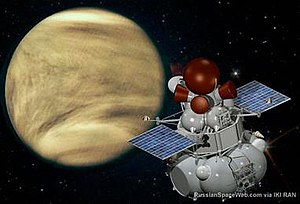 Artist's concept of the Venera-D spacecraft approaching a cloud-veiled Venus | |
| Names | Venera 17 |
|---|---|
| Mission type | Venus orbiter/lander |
| Operator | Roscosmos |
| Mission duration | Orbiter: ≥3 years[1] Lander: >3 hours[2] LLISSE surface probe: ≈90 Earth days[2] |
| Spacecraft properties | |
| Manufacturer | NPO Lavochkin |
| Launch mass | 4,800 kg (10,600 lb)[3] |
| Dry mass | Orbiter: 990 kg (2,180 lb)[4] Lander: 1,600 kg (3,500 lb)[5] |
| Payload mass | Orbiter: 1,200 kg (2,600 lb)[4] Lander: 85 kg (187 lb)[3] |
| Power | Orbiter: 1,700 W [4] |
| Start of mission | |
| Launch date | Proposed: 2031[3] |
| Rocket | Angara A5[4] |
| Launch site | Vostochniy Site 1A[6] |
| Orbital parameters | |
| Reference system | Cytherocentric |
| Regime | Polar |
| Pericytherion altitude | 300 km (190 mi) |
| Apocytherion altitude | 500 km (310 mi)[4] |
| Inclination | 90° |
| Period | 24 hours[4][2] |
| Venus orbiter | |
| Spacecraft component | Orbiter |
| Venus lander | |
| Spacecraft component | Lander |
| Venus Aerial | |
| Spacecraft component | Balloon |
| Transponders | |
| Band | X band, Ka band[4] |
| Capacity | 16 Mbit/sec[4] |
Venera-D (Russian: Венера-Д, pronounced [vʲɪˈnʲɛrə ˈdɛ]) is a proposed Russian space mission to Venus that would include an orbiter and a lander to be launched in 2031.[3] The orbiter's prime objective is to perform observations with the use of a radar. The lander, based on the Venera design, would be capable of operating for a long duration (≈3 h)[2] on the planet's surface. The "D" in Venera-D stands for "dolgozhivuschaya," which means "long lasting" in Russian.[7]
Venera-D will be the first Venus probe launched by the Russian Federation (the earlier Venera probes were launched by the former Soviet Union). Venera-D will serve as the flagship for a new generation of Russian-built Venus probes, culminating with a lander capable of withstanding the harsh Venusian environment for more than the 11⁄2 hours logged by the Soviet probes. The surface of Venus experiences average temperatures of 462 °C (864 °F), crushing 90 bar (89 atm; 1,300 psi) pressures, and corroding clouds of carbon dioxide laced with sulfuric acid. Venera-D will be launched on an Angara A5 rocket.[4]
- ^ Cite error: The named reference
NASA Sciencewas invoked but never defined (see the help page). - ^ a b c d Venera-D: Phase II Final Report. Joint Science Definition Team. 31 January 2019.
- ^ a b c d Zak, Anatoly (5 March 2021). "New promise for the Venera-D project". RussianSpaceWeb. Retrieved 7 March 2021.
- ^ a b c d e f g h i Status Report of the Venera-D Joint Science Definition Team. D. Senske, L. Zasova, A. Burdanov, T. Economou, N. Eismont, M. Gerasimov, D. Gorinov, J. Hall, N. Ignatiev, M. Ivanov, K. Lea Jessup, I. Khatuntsev, O. Korablev, T. Kremic, S. Limaye, I. Lomakin, A. Martynov, A. Ocampo, S. Teselkin, O. Vaisberg, and V. Vorontsov. Lunar and Planetary Institute conference. 11 December 2017.
- ^ Cite error: The named reference
January 2017 Reportwas invoked but never defined (see the help page). - ^ Venera-D Mission Concept for Study Atmosphere, Surface and Plasma Environment of Venus. 42nd COSPAR Scientific Assembly. Held 14–22 July 2018, in Pasadena, California, USA, Abstract id. PEX.1-26-18. July 2018.
- ^ Cite error: The named reference
Joint proposal 2017was invoked but never defined (see the help page).